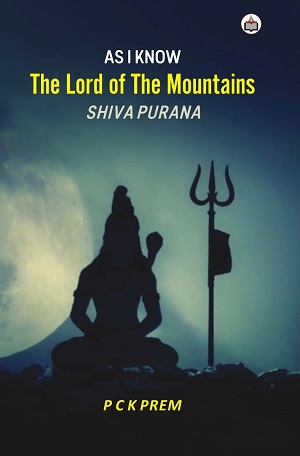Apr 18, 2025
Apr 18, 2025
by P C K Prem
As I Know: The Lord of the Mountains – Shiv Purana: 151
Infinite dimensions of lord are beyond knowledge, nature, man and delusory mystery, prakriti, purusa, bondages, time, destiny etc because the great lord does not recognise such elements…nothing exists for him …Shiva is the lord beyond beginning and…he is the essence of the Vedas
 Quite a number of times, monk Upamanyu made it clear that the great lord Shiva does not recognise any bondage whether of nature or man or delusory world, prakriti, intellect, ego, senses, time, destiny, worship or loathing. He is beyond happiness. Karmas do not affect him. Neither worldly joys nor concept of time – past, present or future exists for him. Neither beginning nor human acts nor end or deadness causes any bang. He is sans bonds and none is identical or equal to him. He is beyond the cycle of birth or rebirth or death. He is neither free nor in bondage. He is symbol of the auspicious and is the eternal soul.
Quite a number of times, monk Upamanyu made it clear that the great lord Shiva does not recognise any bondage whether of nature or man or delusory world, prakriti, intellect, ego, senses, time, destiny, worship or loathing. He is beyond happiness. Karmas do not affect him. Neither worldly joys nor concept of time – past, present or future exists for him. Neither beginning nor human acts nor end or deadness causes any bang. He is sans bonds and none is identical or equal to him. He is beyond the cycle of birth or rebirth or death. He is neither free nor in bondage. He is symbol of the auspicious and is the eternal soul.
He works through powers invisible and so cultured people and the knower of eternal truth call him Shiva. He is the lord of the world in all its aspects good or bad, favourable or wicked, and purifies the world and living beings and never lives in illusion. He is Rudra and Purusa. He is the teacher of the pre-creation age, who teaches scriptures to learned men. Time dies, not the guide. He is eternal and deathless, pure and natural. Radiance and luminosity stay eternal and he is beyond the principles of perfections. Pranava is the symbol of Shiva and Rudra, the eternal and so one reaches him through meditation.
Shiva’s shakti is beyond charismatic form and beyond language. He is one but is present in numerous forms and images, and he is truly the originator of many shaktis and the process of creation of shaktis continues for the benefit of created beings. If illusion or delusion is Prakriti, it is distortion of Jiva. Shakti infuses sat and asat in animate or inanimate created beings. It is omnipresent in the form of illumination and bliss. He is the incomprehensible presiding deity of all causes and Time. Lord’s grace and generosity liberate everyone, so one begins to live a purified life, and union is possible. Welfare of the man and society is supreme, a devotee believes. Staying away from carnal pleasures blesses, and and at the same time, concentration on the lord, the primal cause, grants salvation.
Krishna wants to know about Shiva’s knowledge, which in fact constitutes the essence of the Vedas and is good for the moksa of devotees. The questions naturally arise as to who can pray and worship, and the genuine inquiries also arise about yoga of knowledge – jnana-yoga. Upamanyu tells about the desire of Shiva, who armours with causes and effects, and manifests ‘the self’ from the imperceptible.
The first creation is Brahma, who notices the lord, the father. He creates the world for all beings – livings and non-livings and then Soma – the origin of heaven, earth, fire, sun, yajna, Vishnu and the lord of gods and other gods and so the creation has its areas of operation and restriction. Rudra tells gods that he is the primal cause, who bestows contentment, blessing and magnificence. He is one and alone, and none is greater or equal. The knower of Rudra feels free. At this time, gods praise him, organise holy rites of Pasupata, and smear bodies with bhasma. Gods express doubts and ask as to who are eligible to offer prayers and worship.
To know the image of lord – of eight arms and four faces with half form of female and the other half of male is important. When the gods observe that they find the entire creation in him and so, they bow and pay obeisance and eulogise profusely. Revolution of yuga is a truth even as Shiva descends on earth as an embodiment and spreads the knowledge so that devotees attain deliverance. Vyasa’s incarnations in different yugas spread knowledge and wisdom as preceptors, the principle sources.
They are – Ribbu, Satya, Bhargava, Angiras, Savitar, Indra, Vasistha, Sarsvata, Tridhama, Trivrita, Satateja, Dharma…he tells holy brahmins that the incarnations as gurus of yoga symbolise Shiva. The celebrated among the disciples of Shiva find appropriate descriptions. Among the incarnations, four are the most radiant and brilliant disciples, and they will have numerous followers in future, and the number will go on swelling. Intense devotion purifies them and therefore, they carry out virtuous duties at the request of the lord, and feel liberated.
20-Jul-2024
More by : P C K Prem